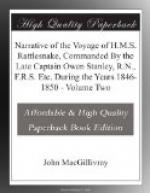(**Footnote. Voyage au Pole Sud et dans l’Oceanie sur les corvettes L’Astrolabe et la Zelee pendant les annees 1837 a 1840. Sous le commandement de M. J. Dumont D’Urville. Histoire du Voyage tome 9 pages 208 a 215. Atlas Hydrographique Plate 1.)
CAPTAIN F.P. BLACKWOOD.
During his survey of the northern and eastern entrances of Torres Strait, Captain F.P. Blackwood, in H.M.S. Fly, spent two months in 1845, upon the south-east coast of New Guinea, 140 miles of which, including that part seen by Bampton and Alt in 1793, was surveyed as completely as the time and means would permit. This country presented a great sameness of aspect; low muddy shores covered at first with mangroves, and, further back, with dense forests, were found to be intersected by numerous channels of fresh water, the mouths, there is reason to suppose, of one or more large rivers, of which this great extent of country is the delta. Great mudbanks, extending from ten to twenty miles out to sea, prevented approach except in the boats. Several of these channels were entered by the surveying parties, and one (Aird River) was ascended by Captain Blackwood to the distance of twenty miles from its mouth. Many villages were seen scattered along the coast and on the river banks. The natives, apparently closely resembling the Torres Strait Islanders, appeared to be a savage and warlike race, and refused to have any friendly intercourse with the white men, whose boats they attempted to cut off on various occasions. They seemed to be perfectly naked, and their principal weapons were observed to be bows and arrows and wooden sword-like clubs.*
(Footnote. Narrative of the Surveying Voyage of H.M.S. Fly, commanded by Captain F.P. Blackwood, R.N. by J.B. Jukes, Naturalist to the Expedition, volume 1 page 282 etc.)
LIEUTENANT C.B. YULE.
In the following year, a further addition to the survey of the south-east coast of New Guinea was made by Lieutenant C.B. Yule, while in command of H.M. Schooners Bramble and Castlereagh. This survey was commenced at Cape Possession, and continued to the westward and northward as far as Cape Blackwood, where the Fly’s work ended, a distance equal to two degrees of longitude.* Many large river mouths were observed, the fresh water on one occasion extending two or three miles out to sea. The country had ceased to present the low monotonous appearance shown to the westward, and had become more broken with wooded hills, and on the extreme east, ranges of lofty mountains were seen in the distance; one of these (Mount Yule) attains an elevation of 10,046 feet. Landing was attempted only once, on which occasion the whole party—their two boats having been capsized in the surf, and their ammunition destroyed—were set upon by a large body of natives and plundered of everything, even to their clothes, but not otherwise injured, although completely at the mercy of these savages.




